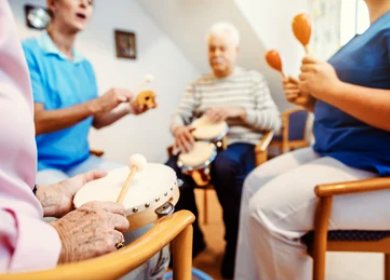Music therapy sessions include playing instruments, singing, songwriting, music analysis, dancing, clapping, tapping, and therapeutic listening to music. Each music therapy session is different and each therapist responds in a unique way to people’s need for creative guidance.
What Happens During A Music Therapy Session?
In a typical music therapy session, the music therapist and client create music with voice, percussion instruments, and other musical instruments, like guitar or piano. Alternatively, the therapist may get clients to listen to music to encourage movement like standing, dancing, tapping their toes, or clapping their hands.
While certain components of a music therapy session will vary, depending on the client, age, and group size, during a session, music is used for a goal or purpose.
The therapist will try to ensure that the lyrics, melodies, and selected pieces of music match the mood and psychological state of the therapist.
Some therapists use drums to involve patients more in their therapy and to help them get into conversation with each other.
They offer patients different types of drums so they can play the accompanying music. They frame the musical experience as something to listen to, which can lead to a discussion and help you to gain new insights and perspectives.
Sessions look different for every music therapist who works with different age groups and demographics with many different goals. Each session is different and tailored to the individual needs and preferences of each client group.
Are Music Therapy Sessions Individual Or In Groups?
Music therapy sessions can be done individually or as groups. Individual sessions focus more on communication, behavior, and cognitive skills, while group sessions focus more on taking turns, interacting, and appropriately communicating with their peers.
Individuals that are working on social goals can focus on improving those skills quicker in a one-on-one setting so that they can transition into group sessions quicker and easier. Although it might seem these goals would something for a group music therapy session, it takes time to teach and learn the new skills.
Group sessions are beneficial as they help clients social skills in real experiences, allowing them to put their skills into practice with their peers.
Musical performance techniques can be used in groups too. Sessions can include the use of pre-composed songs, music games, activities, and songwriting. And, musical instruments can be used to involve multiple patients at the same time.

What Can Music Therapy Be Used For?
The therapeutic use of music can help people in ways that other forms of therapy cannot or it can provoke reactions that do not occur in traditional treatments.
Bruscia (1991) defined music therapy as “an interpersonal process in which the therapist uses music and its facets to help patients improve, restore or maintain their health” (Maratos, Gold, Wang, & Crawford, 2008).
A new definition of music therapy proposes Little (1998) and Bruscia an alternative definition of a systematic intervention process in which a therapist helps his clients promote health by using musical experiences and relationships formed through musical experiences as a dynamic force for change” (Geretsegger, Elefant, Mossler & Gold, 2014 ).
As an example, many people find that music and non-white noise helps them fall asleep. Compared to drugs and other commonly prescribed treatments for sleep disorders, music is less intrusive and for everyone less expensive to manage their own illness. Listening to music can be enjoyable, but every therapy is different.
Music therapists conduct therapy sessions in which clients participate in music-related activities to enhance their physical and mental well-being.

1 thought on “What Is A Typical Music Therapy Session Like?”
Comments are closed.